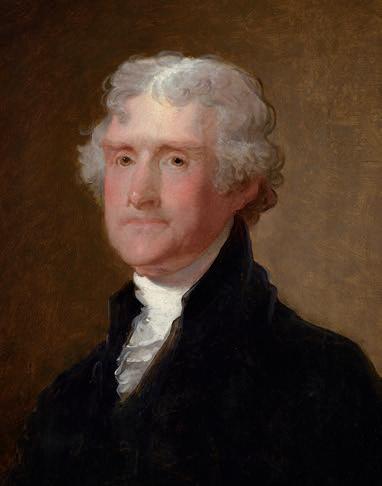Eyes on Oregon

Located off the Gulf of Mexico, New Orleans controlled entrance to the Mississippi River. And the Mississippi River controlled trade and transportation in the interior of North America. Jefferson did not want a foreign country controlling the fate and future growth of the United States.
In December 1803, the United States purchased France’s entire Louisiana territory. The deal included New Orleans and a vast expanse of land that extended west of the Mississippi River. It doubled the size of the United States.
Jefferson had long been curious about what might be found in those western lands. In the early 1800s, most Americans lived east of the Mississippi River. Jefferson appointed his secretary, Meriwether Lewis, to lead an expedition into the new Louisiana Purchase.
Lewis and his co-captain, William Clark, set out with the men chosen for their Corps of Discovery in the spring of 1804. Jefferson asked the men to look for a water route from the Missouri River to the Pacific Ocean. He encouraged them to learn about the Indigenous peoples and to note plants and animals. He also hoped the expedition would strengthen U.S. claims to the rich farmlands of the Pacific Northwest.
Americans knew about the Pacific Northwest because of its role in the North American fur trade. The trade had started between the Indigenous peoples and the first European explorers in the early 1600s. The pelts of fur-bearing animals in North America were turned into desirable warm clothing and hats in Europe. The trade developed into an enormously profitable industry. In their search for animals to meet the demand, fur trappers had reached the Pacific Coast. In 1792, American ship captain Robert Gray had sailed to the mouth of the Columbia River and claimed it for the United States.
This story is from the {{IssueName}} edition of {{MagazineName}}.
Start your 7-day Magzter GOLD free trial to access thousands of curated premium stories, and 9,500+ magazines and newspapers.
Already a subscriber ? Sign In
This story is from the {{IssueName}} edition of {{MagazineName}}.
Start your 7-day Magzter GOLD free trial to access thousands of curated premium stories, and 9,500+ magazines and newspapers.
Already a subscriber? Sign In

nellie Bly Journalist
nellie Bly's first newspaper articles appeared in print when she was just 20 years old.

Arabella Mansfield -Lawyer
Arabella Mansfield started out life as Belle Babb (1846-1911). She grew up in a Midwest family that valued education. In 1850, her father left to search for gold in California. He died in a tunnel accident a few years later.

Sarah Josepha Hale Editor
Long before Vogue or Glamour caught women's attention, Godey's Lady's Book introduced the latest fashions.

Louise Blanchard Bethune - Architect
Louise Blanchard Bethune (1856-1915) showed early promise in math. Lucky for her, her father was the principal and a mathematics teacher in a school in Waterloo, New York. Instead of going to school, Louise's father taught her at home until she was 11 years old. She also discovered a skill for planning houses. It developed into a lifelong interest in architecture and a place in history as the first professional female architect in the United States.

Sojourner Truth Speaker
There was a time when slavery wastes abolished the institution over a number of decades. New York abolished slavery in 1827. Isabella Baumfree (c. 1797-1883) was born enslaved in Hurley, New York. When she was nine, she was taken from her parents and sold. She then was sold several more times. Some of her owners were cruel and abused her. During that time, she had several children.

Getting Started
In this editorial cartoon, a young 19th-century woman must overcome the obstacle of carrying a heavy burden while climbing a multirung ladder before she can achieve \"Equal Suffrage.\"

Leonora M. Barry - Investigator
When Leonora M. Barry (1849-1923) was a young girl, her family left Ireland to escape a famine. They settled in New York. Barry became a teacher. In 1872, she married a fellow Irish immigrant. At that time, married women were not allowed to work. So, Barry stayed home to raise their three children.

Finding a New Path
For many Americans, this month's mystery hero represents the ultimate modern trailblazer. She is recognized by just her first name.

The Grimké Sisters Abolitionists
Every night, Dinah was supposed to brush the E hair of her mistress, Sarah Moore Grimké (1792-1873). But one night, 12-year-old Sarah stopped Dinah. She wanted to help Dinah instead. They had to be quiet so they wouldn't get caught. It was 1804 in Charleston, South Carolina. The Grimkés were among Charleston's major slaveholding families. Strict laws regulated the behavior of both master and enslaved people.

Frances Willard Leader
During Frances Willard's lifetime (1839-1898), she was the best-known woman in America: She headed the largest women's organization in the worldthe Woman's Christian Temperance Union (WCTU). In that role, her abilities shone as a social activist, a dynamic speaker, and a brilliant organizer. She educated women on how to run meetings, write petitions, give speeches, and lobby state and federal legislators.
